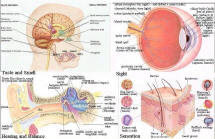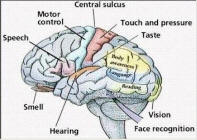Neurology Anatomy Physiology
December 14, 2021
Sences Organs
continued from the Brain Page of Nervous System
Contents
neurons and Nervesneurotransmitter
The Brain & Spinal Cord
Cranial Nerves
Peripheral Nervous System
Autonomic Nervous System
Senses: Eye diagrams, Hearing,Smell,Taste, Taste & Tongue Sensation,Balance
Memory , Memory types, Creation of Memory,
Higher Functions
Altered States
Senses


Senses organs receive external and internal stimuli; therefore, they are called receptors. Each type of receptor is sensitive to only one type of stimulus as listed Table 05, while Figure 09 shows many types of receptors. When a receptor is stimulated, it generated nerve impulses that are transmitted to the spinal cord and/or the brain, but we are conscious of a sensation only if the impulses reach the cerebrum.
Figure 09 Senses
[view large image]
Figure 10 Cerebrum Mapping [view large image]
Krause end bulbs Radioreceptor
Hot-cold Heat flow Merkel's and Meissner's endings
Mechanoreceptor Touch Mechanical displacement of tissue Pacinian corpuscles MechanoreceptorPressureMechanical displacement of tissue Free nerve endings Chemoreceptor Pain Tissue damage Proprioceptors Mechanoreceptor Limb placement Mechanical displacement Special Eye Radioreceptor Sight Light Ear Mechanoreceptor Hearing Sound wave Olfactory cells Chemoreceptor Smell Chemicals Taste budsChemoreceptorTasteChemicalsTable 05 Receptors
The general receptors distribute all over the skin. They are usually grouped together as sensation. The special receptors locate only at certain part of the body in the head. Altogether, they are referred to as the five senses. The followings present a further break down into components, and functions.
continue to Eye diagrams
Powered by cidpusa.org